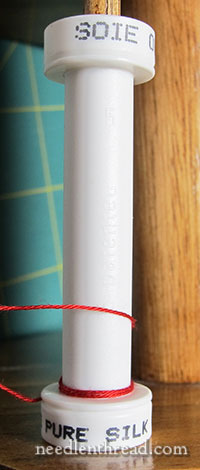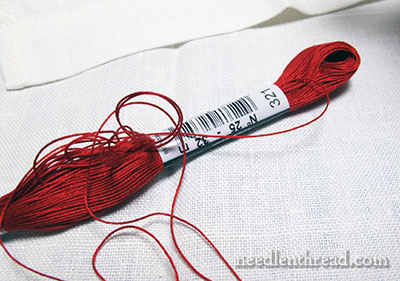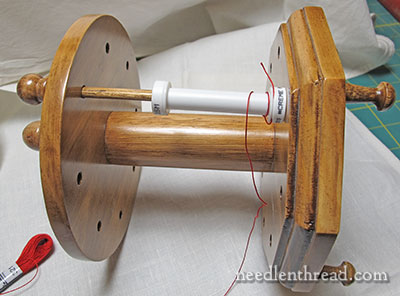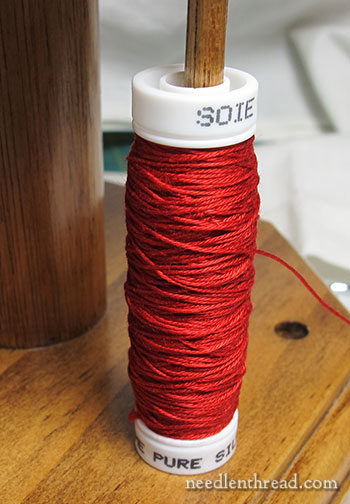Many brands of sewing threads and several brands of embroidery threads are spooled up these days on plastic snap spools.
On each end of a snap spool, the “head” of the spool lifts up a little bit so that you can anchor your loose thread underneath the lip of that liftable head, and snap the spool closed again – a convenient way to anchor the loose end of the thread.
If you use sewing threads packaged on these kinds of spools – or embroidery threads (certain Au Ver a Soie silks come on them, as well and Londonderry Linen thread, Trebizond, and others) – when you’re finished with the spool, don’t pitch it!
I re-use empty spools often, and here’s one way I recently put one to use.

I am contemplating an experiment. A test. I have a notion that I can take a kind of “short cut” on a project, and once I test my theory, I will share it with you – whether it turns out to be one of those happy moments of triumphant success … or an abject failure.
Before I can test my theory, though, I had to overcome one small difficulty.
Enter, the pull skein.

Perhaps I should call it the Unpredictable Pull Skein. The Highly Temperamental Pull Skein. The made-to-irritate-me-and-drive-me-nuts pull skein.
I’ve written about the frustrations of pull skeins before. You see, it never fails. Whenever I think I’ve got The End (as in, the Correct End) and that the whole skein is going to pull out smoothly and cooperatively, it happens.
It bunches. It knots. It stops pulling.
We’ve all experienced it, I’m sure – it’s just one of those minor inconveniences to which we become accustomed.

Well, for my proposed experiment to progress without a hitch, I couldn’t have a pull skein that refused to cooperate.
So I decided to spool up the pull skein onto a snap spool.
I snapped one end of the thread from the pull skein (the Correct End, I hoped!) onto the empty spool, mounted the spool onto one of the pins of my spool holder, and proceeded to wind the thread onto the spool.
At first, I figured it would be a two-minute job, well worth the time. It actually turned out to be a twelve-minute job, but I still think it was worth the time.
The trick is to keep tension on the thread coming off the skein, moving it back and forth along the spool in the same way that a bobbin on a sewing machine loads, while turning the spool with your other hand.
Half way through the experience, I wondered if I could use my sewing machine bobbin winder somehow to do the turning. Why didn’t that occur to me before I started? If I need another spool, I may try that!

In the meantime, though, this worked out pretty well. Yes, it took twelve minutes, but if my deep, dark, secret plan works, it will be well worth it!
Given this recent topics on Needle ‘n Thread, and given the fact that this thread is used profusely on one project I started within the last year, you’ll probably guess what I’m planning to do….
But it’s more fun to be mysterious.







Aha! You’ve got plans for putting the spool of floche onto the edge of your frame, and then you’ll be tambouring away on the Hungarian runner like there is no tomorrow.
I love the project you are working with this thread ! I might try the spool winding thing …but only so long as it doesn,t unwind all curly..that would annoy me even more ! Also where can you write the thread number ?
Hi, Debs – Well, I didn’t actually label the spool because I don’t really need to. I know what kind of thread it is, and what color, and I’m storing it with all the other thread of the same kind and color. But if you needed to, you could always cut a tiny label for those rims where the writing is. I little slice of a computer label would probably work.
I prefer thread off a spool – it might have a slight wave to it, but nothing at all compared to those kinks that happen when loading thread onto those flat cardboard bobbins! Cotton won’t normally retain a tight curl, anyway, and silk on a spool generally doesn’t, either.
I am popping my forehead when reading this article! Why didn’t I think of that?! I can’t wait to see what is next.
I have a little trick for the skeins that seems to work well for me when I’m wrapping a floss card and might just make your life a little less knotty. Stick your finger through one of the skein loop ends. Try to do it in a way that you can the open the skein in one big loop and drop it over your wrist. I’m right handed and putting it on that wrist means my fingers can control the tension as I wrap the floss around a card. Since the loop is around my wrist, it doesn’t matter which end I grab. It rarely knots or bunches.
I do this too Cindy and it really helps me. Mary, I can’t wait to try to wind floss on a spool using my bobbin winder….i’ll let you know the results. i’m immersed in craft show crazy as my first show is this weekend and i’m busy boxing, etc. but first chance i get i’mm gonna try it on my sidewinder. i have lots of those little spools around from my embroidery machine…..lol
Dear Mary
Yes I save my spools bit didn’t realise that the top lifted up thats handy now I can reuse them for winding spare thread. I do like your spool holder and very useful for winding/unwinding thread, I’m looking for one but they are very difficult come by in the UK. Oh I hope more Tambouring as I would love a tutorial and what a great way to use your tambouring skills on the Hungarian red runner.
Regards Anita Simmance
That big wooden gizmo is just for winding thread or does it do more? It’s so pretty.
When I wind thread onto those flat cardboard bobbins, I use one of those plastic winders that sit on a floss box and I crank away. Not the same as a spool of course. But what I was going to say is I unwind my whole skein of floss onto the floor, carefully laying it out in big sweeps to the right, then left, then right in front of me. No tangles then as I wind.
There is a trick to this method though: if you have cat in the home, make sure they’re asleep in the other room or you end up doing a lot of yelling. LOL
Hi, Irene – that’s actually a spool holder. You can stick some 8 or so spools of thread on it, to use while sewing, embroidering, tambouring….
Hey Mary! I’m not sure it’s worth the money (or space to you) but you can buy all manner of bobbin winders made for weaving. They range from hand operated to electric (very quick work). If you know someone mechanical they can rig one up with a simple motor, and foot pedal–
I agree with Nina! I’m a lapsed weaver, but I kept all my tools and they have come in handy so many times. I have a hand crank bobbin winder that I think would be perfect for winding these little spools assume that they fit on the post. It’s geared so that you turn the handle once and it rotates the bobbin many times so it’s easier to load up. I don’t know that I’d recommend an electric one as it’d be too easy to get out of control if your skein wasn’t pulling smoothly and the length of thread involved in what you want to do here is fairly small compared to what weavers need 🙂
Genius. Just pure genius.
Hi Mary,
I also save my regular sewing thread spools and use them to hold embroidery threads and flosses. Of course they don’t have the neat little top that holds the thread in place. I will usually put them in a small snack sack to keep them clean.
Barbara La Belle
What a great idea. Thank you for the tip.
I’ve been saving old spools and re-using them for ages – and hand winding every one! The idea of using the machine is so obvious – so why didn’t I think of it? If you’ve got a spring grabby thingy on the bobbing winder and the spool fits, it will probably work out just fine – as long as the original skein is easy to unroll. I always place the skein on an expandable yarn winder that’s usually used for spinning and then wind it off that onto the spool.
Notice how NO one is extolling the merits of pull skeins? LOL! 😀
Thanks for your reply Mary , I love the spool holder . It is just such a useful and lovely thing ! I do look forward to reading what you are working on .Debs
What a terrific idea, thanks for sharing it with all of us.
The idea is not new. Another method I have come across, and one open to modification is this. Take an old card, birthday or Christmas type, and fold it over. Wrap some quilt wadding around the middle. Wind the thread over the quilt wadding, remembering to slide the end through a little anchoring the end through another cut in the bottom of the card. Label the card clearly at the top. The wadding prevents folds and bumps in the thread. Some people print their own card spools like this and mine have photos on them. Reused cards work just as well.
I recently read, I thought it was here but maybe not, to pull the end of the skein that has the color number on it. So far I’ve done about five small Halloween cross stitches and haven’t had the frustration of my thread knotting!
Hi Mary,
I have followed you for a long time. You have been very helpful to me especially since my LNS has closed. The next closest is 90 miles away.
Anyway I love your idea for using the empty
spools. I have saved mine for some time
just knowing someday I would find a use for them.
Could you please tell me where to purchase a spool holder. What a great idea. I have never seen one before.
Thank you, Debbie from Santa Rosa
Hi, Debbie – I found mine on eBay. They have several antique ones on there now with the pin cushions at the top, but I haven’t seen this style listed on there for a while. There were several listed at the time I got this. I’m sure they were made new, as a “reproduction” of an antique one. I think it’s just a matter of keeping an eye out for one that you like. ~MC
Well….all I can think of right now is DUH, as I smack myself upside the head. All these years I’ve been throwing away perfectly good organizational tools! Now I’m looking at those spools with the realization that I could wind all sorts of embroidery threads onto them. WHY on earth didn’t I think of that???? Thanks, Mary…you’re wonderful!
I’m late to the discussion, but wanted to add. I recently made a beaded basket kit from Thistle
Threads where it was recommended that, after stringing all the beads needed onto a thin wire, we then wrap the wire around an empty spool. It tamed the extra long piece of wire, and made the work of actually using the stuff much easier. I thought it was a brilliant tip!
I’ve used my wool winder and a cardboard tube to wind and store my threads before now. The tubes I had were *exactly* the same diameter as the winder spool so I couldn’t wind the thread on directly, I had to carefully slide it on afterwards, but it was quick, easy to maintain tension, and there was enough tube at either end to write the colour number on. A small slit cut into the tube held the loose end when I wasn’t working with it, and stopped it unravelling in storage.
Mary, it’s years after your post, but today I came across this intriguing Floss (un)Winder from LolliAndGrace on Etsy:
https://www.etsy.com/listing/602087173/thread-winder-embroidery-thread-floss
It looks kind of like a yarn swift, but for floss. I have no idea how well it works, but perhaps it is the solution to winding floss skeins onto spools without tangles. BTW, I also save and reuse all my empty spools…although it seems that I collect Au Ver a Soie faster than I use it.
I’ve learned so much from you over the years; thanks so much for generously sharing your knowledge with us!
Hello,
Where would I find a wooden spool holder of the kind that holds the red thread.
I am thinking to buy a hand wrapped ball of linen threadand am wondering how I could get it onto a spool to use on the sewing machine?